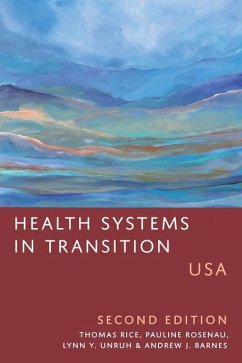Thomas Rice, Pauline Rosenau, Lynn Y Unruh, Andrew J Barnes
Health Systems in Transition
Usa, Second Edition
Thomas Rice, Pauline Rosenau, Lynn Y Unruh, Andrew J Barnes
Health Systems in Transition
Usa, Second Edition
- Broschiertes Buch
- Merkliste
- Auf die Merkliste
- Bewerten Bewerten
- Teilen
- Produkt teilen
- Produkterinnerung
- Produkterinnerung
The book provides a thorough review of the U.S. health care system, including its organization and financing, care delivery, recent reforms, and an evaluation of the system’s performance.
Andere Kunden interessierten sich auch für
![Under the Skin Under the Skin]() Linda VillarosaUnder the Skin16,99 €
Linda VillarosaUnder the Skin16,99 €![Health Care in Crisis Health Care in Crisis]() Theresa MorrisHealth Care in Crisis38,99 €
Theresa MorrisHealth Care in Crisis38,99 €![The Unseen Things The Unseen Things]() Kathryn A RhineThe Unseen Things33,99 €
Kathryn A RhineThe Unseen Things33,99 €![Pain Killer Pain Killer]() Barry MeierPain Killer18,99 €
Barry MeierPain Killer18,99 €![Supporting People Living with Dementia in Black, Asian and Minority Ethnic Communities Supporting People Living with Dementia in Black, Asian and Minority Ethnic Communities]() Supporting People Living with Dementia in Black, Asian and Minority Ethnic Communities37,99 €
Supporting People Living with Dementia in Black, Asian and Minority Ethnic Communities37,99 €![Businesses with a Difference Businesses with a Difference]() Laurie MookBusinesses with a Difference52,99 €
Laurie MookBusinesses with a Difference52,99 €![Woman and the New Race Woman and the New Race]() Margaret SangerWoman and the New Race15,99 €
Margaret SangerWoman and the New Race15,99 €-
-
-
The book provides a thorough review of the U.S. health care system, including its organization and financing, care delivery, recent reforms, and an evaluation of the system’s performance.
Hinweis: Dieser Artikel kann nur an eine deutsche Lieferadresse ausgeliefert werden.
Hinweis: Dieser Artikel kann nur an eine deutsche Lieferadresse ausgeliefert werden.
Produktdetails
- Produktdetails
- Verlag: University of Toronto Press
- 2nd edition
- Seitenzahl: 504
- Erscheinungstermin: 20. Oktober 2021
- Englisch
- Abmessung: 241mm x 160mm x 51mm
- Gewicht: 821g
- ISBN-13: 9781487526450
- ISBN-10: 1487526458
- Artikelnr.: 59083797
- Herstellerkennzeichnung
- Libri GmbH
- Europaallee 1
- 36244 Bad Hersfeld
- gpsr@libri.de
- Verlag: University of Toronto Press
- 2nd edition
- Seitenzahl: 504
- Erscheinungstermin: 20. Oktober 2021
- Englisch
- Abmessung: 241mm x 160mm x 51mm
- Gewicht: 821g
- ISBN-13: 9781487526450
- ISBN-10: 1487526458
- Artikelnr.: 59083797
- Herstellerkennzeichnung
- Libri GmbH
- Europaallee 1
- 36244 Bad Hersfeld
- gpsr@libri.de
Thomas Rice is an economist and a Distinguished Professor in the Department of Health Policy and Management at the UCLA Fielding School of Public Health.
Preface
Acknowledgements
List of abbreviations
List of tables, figures and boxes
Abstract
Executive summary
1 Introduction
1.1 Geography and sociodemography
1.2 Economic context
1.3 Political context
1.4 Health status
2 Organization and governance
2.1 Historical background
2.2 Organization of the healthcare system
2.3 Decentralization and centralization
2.4 Planning
2.5 Intersectorality
2.6 Patient empowerment
2.7 Regulation
3 Financing
3.1 Health expenditure
3.2 Sources of revenue, financing and financial flows
3.3 Medicare
3.4 Medicaid
3.5 Private health insurance
3.6 Out-of-pocket payments
3.7 Payment mechanisms
4 Physical and human resources
4.1 Physical resources
4.2 Human resources
5 Provision of services
5.1 Patient pathways
5.2 Public health
5.3 Outpatient services: primary care
5.4 Outpatient services: specialty care
5.5 Other outpatient services: ambulatory surgical, emergency and urgent
care
5.6 Acute inpatient care
5.7 Dental care
5.8 Behavioural healthcare
5.9 Pharmaceutical care
5.10 Post-acute care: rehabilitation, intermittent home care and subacute
care
5.11 Long-term care
5.12 Palliative care
5.13 Services from informal care-givers
5.14 Racial and ethnic minorities, low-income individuals, the uninsured
and other vulnerable populations
6 Principal health reforms
6.1 History of US health reforms
6.2 The Affordable Care Act
6.3 The future of the ACA
7 Assessment of the health system
7.1 Health system governance
7.2 Accessibility
7.3 Financial protection
7.4 Healthcare quality
7.5 Health outcomes
7.6 Health system efficiency
8 Conclusions
9 Appendices
9.1 References
9.2 Useful websites
9.3 HiT methodology and production process
9.4 About the authors
Acknowledgements
List of abbreviations
List of tables, figures and boxes
Abstract
Executive summary
1 Introduction
1.1 Geography and sociodemography
1.2 Economic context
1.3 Political context
1.4 Health status
2 Organization and governance
2.1 Historical background
2.2 Organization of the healthcare system
2.3 Decentralization and centralization
2.4 Planning
2.5 Intersectorality
2.6 Patient empowerment
2.7 Regulation
3 Financing
3.1 Health expenditure
3.2 Sources of revenue, financing and financial flows
3.3 Medicare
3.4 Medicaid
3.5 Private health insurance
3.6 Out-of-pocket payments
3.7 Payment mechanisms
4 Physical and human resources
4.1 Physical resources
4.2 Human resources
5 Provision of services
5.1 Patient pathways
5.2 Public health
5.3 Outpatient services: primary care
5.4 Outpatient services: specialty care
5.5 Other outpatient services: ambulatory surgical, emergency and urgent
care
5.6 Acute inpatient care
5.7 Dental care
5.8 Behavioural healthcare
5.9 Pharmaceutical care
5.10 Post-acute care: rehabilitation, intermittent home care and subacute
care
5.11 Long-term care
5.12 Palliative care
5.13 Services from informal care-givers
5.14 Racial and ethnic minorities, low-income individuals, the uninsured
and other vulnerable populations
6 Principal health reforms
6.1 History of US health reforms
6.2 The Affordable Care Act
6.3 The future of the ACA
7 Assessment of the health system
7.1 Health system governance
7.2 Accessibility
7.3 Financial protection
7.4 Healthcare quality
7.5 Health outcomes
7.6 Health system efficiency
8 Conclusions
9 Appendices
9.1 References
9.2 Useful websites
9.3 HiT methodology and production process
9.4 About the authors
Preface
Acknowledgements
List of abbreviations
List of tables, figures and boxes
Abstract
Executive summary
1 Introduction
1.1 Geography and sociodemography
1.2 Economic context
1.3 Political context
1.4 Health status
2 Organization and governance
2.1 Historical background
2.2 Organization of the healthcare system
2.3 Decentralization and centralization
2.4 Planning
2.5 Intersectorality
2.6 Patient empowerment
2.7 Regulation
3 Financing
3.1 Health expenditure
3.2 Sources of revenue, financing and financial flows
3.3 Medicare
3.4 Medicaid
3.5 Private health insurance
3.6 Out-of-pocket payments
3.7 Payment mechanisms
4 Physical and human resources
4.1 Physical resources
4.2 Human resources
5 Provision of services
5.1 Patient pathways
5.2 Public health
5.3 Outpatient services: primary care
5.4 Outpatient services: specialty care
5.5 Other outpatient services: ambulatory surgical, emergency and urgent
care
5.6 Acute inpatient care
5.7 Dental care
5.8 Behavioural healthcare
5.9 Pharmaceutical care
5.10 Post-acute care: rehabilitation, intermittent home care and subacute
care
5.11 Long-term care
5.12 Palliative care
5.13 Services from informal care-givers
5.14 Racial and ethnic minorities, low-income individuals, the uninsured
and other vulnerable populations
6 Principal health reforms
6.1 History of US health reforms
6.2 The Affordable Care Act
6.3 The future of the ACA
7 Assessment of the health system
7.1 Health system governance
7.2 Accessibility
7.3 Financial protection
7.4 Healthcare quality
7.5 Health outcomes
7.6 Health system efficiency
8 Conclusions
9 Appendices
9.1 References
9.2 Useful websites
9.3 HiT methodology and production process
9.4 About the authors
Acknowledgements
List of abbreviations
List of tables, figures and boxes
Abstract
Executive summary
1 Introduction
1.1 Geography and sociodemography
1.2 Economic context
1.3 Political context
1.4 Health status
2 Organization and governance
2.1 Historical background
2.2 Organization of the healthcare system
2.3 Decentralization and centralization
2.4 Planning
2.5 Intersectorality
2.6 Patient empowerment
2.7 Regulation
3 Financing
3.1 Health expenditure
3.2 Sources of revenue, financing and financial flows
3.3 Medicare
3.4 Medicaid
3.5 Private health insurance
3.6 Out-of-pocket payments
3.7 Payment mechanisms
4 Physical and human resources
4.1 Physical resources
4.2 Human resources
5 Provision of services
5.1 Patient pathways
5.2 Public health
5.3 Outpatient services: primary care
5.4 Outpatient services: specialty care
5.5 Other outpatient services: ambulatory surgical, emergency and urgent
care
5.6 Acute inpatient care
5.7 Dental care
5.8 Behavioural healthcare
5.9 Pharmaceutical care
5.10 Post-acute care: rehabilitation, intermittent home care and subacute
care
5.11 Long-term care
5.12 Palliative care
5.13 Services from informal care-givers
5.14 Racial and ethnic minorities, low-income individuals, the uninsured
and other vulnerable populations
6 Principal health reforms
6.1 History of US health reforms
6.2 The Affordable Care Act
6.3 The future of the ACA
7 Assessment of the health system
7.1 Health system governance
7.2 Accessibility
7.3 Financial protection
7.4 Healthcare quality
7.5 Health outcomes
7.6 Health system efficiency
8 Conclusions
9 Appendices
9.1 References
9.2 Useful websites
9.3 HiT methodology and production process
9.4 About the authors








